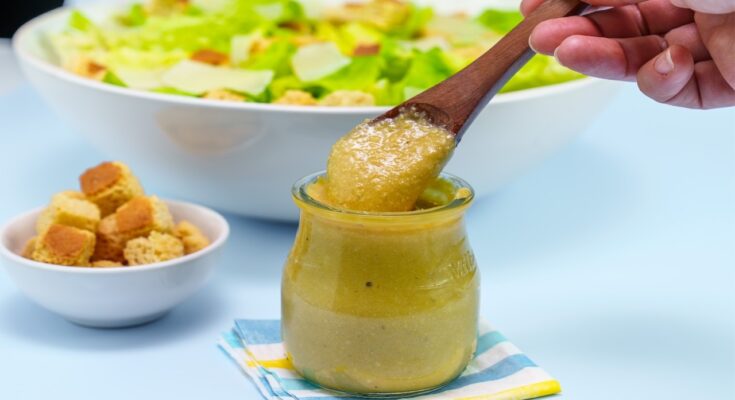Caesar Salad Dressing Recipe: Caesar salad dressing is a timeless classic that elevates the simple salad into a luxurious dining experience. Whether you’re a fan of its rich, tangy flavor or want to recreate your favorite restaurant-style salad at home, mastering this recipe is a must.
The beauty of homemade Caesar dressing lies in its balance—creamy yet light, with just the right hit of umami from anchovies and Parmesan. Plus, making it yourself ensures freshness, full control over ingredients, and a sense of accomplishment!
Ready to dive in? Let’s break it down step by step.
Ingredients for Caesar Salad Dressing
To make authentic Caesar salad dressing, you’ll need the following ingredients:
- Egg yolks (2 large): The base for emulsification.
- Garlic (2 cloves): Adds a robust flavor.
- Anchovies (4-5 fillets): Provides a savory, umami kick.
- Dijon mustard (1 tsp): Helps with emulsification and adds a tangy note.
- Lemon juice (2 tbsp): Freshly squeezed for brightness.
- Olive oil (½ cup): For a silky, rich texture.
- Worcestershire sauce (1 tsp): Adds depth and complexity.
- Grated Parmesan cheese (¼ cup): Brings creaminess and umami.
- Salt and freshly ground black pepper (to taste).
Substitutes and Tips:
- Use pasteurized egg yolks if concerned about raw eggs.
- Replace anchovies with capers for a vegetarian version.
- Experiment with oils: a mix of olive oil and neutral oil balances flavor.
Tools You’ll Need
Having the right tools makes preparation a breeze. Gather these essentials:
- Cutting board and sharp knife: For mincing garlic and anchovies.
- Mixing bowl: Preferably stainless steel for whisking.
- Whisk or blender: For emulsifying the dressing.
- Measuring cups and spoons: To ensure accuracy.
- Microplane or grater: For freshly grated Parmesan.
- Storage jar: To keep leftovers fresh.
Optional tools like a mortar and pestle for grinding garlic can add authenticity to the process.
Preparing the Ingredients
Preparation is key to a smooth workflow. Here’s how to prep each ingredient:
- Garlic: Peel and finely mince or crush it into a paste for an even distribution of flavor.
- Anchovies: Chop finely or mash them with the back of a knife for seamless blending.
- Lemon juice: Roll the lemon on a countertop before cutting to extract maximum juice.
- Egg yolks: Separate the yolks carefully, ensuring no whites are mixed in.
Fresh, high-quality ingredients ensure your dressing will taste restaurant-quality every time.
Classic Caesar Dressing Step-by-Step Recipe
Let’s get into the nitty-gritty of making the perfect Caesar dressing.
Step 1: Mince Garlic and Anchovies
Start by combining minced garlic and anchovies on a cutting board. Using the side of your knife, mash them into a paste. This step ensures the anchovies and garlic integrate smoothly into the dressing.
Step 2: Mix the Base
In a mixing bowl, combine the egg yolks and Dijon mustard. Whisk vigorously until the mixture becomes creamy. This step is crucial for forming a stable base for emulsification.
Step 3: Add Flavorings
Whisk in the lemon juice, Worcestershire sauce, and a pinch of salt and pepper. These ingredients provide acidity, depth, and seasoning to balance the richness of the yolks and oil.
Step 4: Blend or Whisk
While continuously whisking, slowly drizzle in the olive oil. Start with a few drops at a time, gradually increasing the flow as the mixture thickens. If using a blender, add oil in a steady stream through the feed tube.
Step 5: Adjust Texture and Taste
Taste the dressing and adjust with more lemon juice, salt, or water for consistency. For an ultra-smooth texture, consider blending in grated Parmesan cheese at the end.
Tips for Perfect Caesar Salad Dressing
- Always use room-temperature ingredients to aid emulsification.
- If the dressing separates, whisk in a teaspoon of water to bring it back together.
- Avoid over-salting—Parmesan and anchovies are naturally salty.
Variations of Caesar Salad Dressing
If you’re looking to switch things up or adapt Caesar salad dressing to your dietary needs, here are some creative and delicious variations:
Vegan Caesar Dressing
- Replace egg yolks with soaked cashews or silken tofu for creaminess.
- Swap Parmesan for nutritional yeast to maintain the cheesy flavor.
- Use capers or miso paste instead of anchovies for that umami punch.
Low-Calorie Caesar Dressing
- Substitute mayonnaise or Greek yogurt for egg yolks to reduce calories.
- Add a splash of apple cider vinegar for tang instead of oil-heavy mixtures.
- Mix with water or unsweetened almond milk for a lighter texture.
Spicy Caesar Dressing
- Add a pinch of cayenne pepper or a splash of hot sauce for heat.
- Blend in a roasted jalapeño for a smoky, spicy twist.
Herby Caesar Dressing
- Toss in freshly chopped parsley, dill, or basil to add a refreshing herbal note.
- Perfect for summer salads and grilled vegetables.
How to Store Caesar Salad Dressing
Homemade Caesar dressing can be stored for later use, but proper storage is crucial to maintain its quality and safety. Here’s how:
- Use an airtight container: A glass jar with a lid is ideal.
- Refrigerate immediately: Keep the dressing chilled to prevent spoilage.
- Shelf life: Store for up to 3-5 days due to the raw egg yolks.
Pro Tip: If the dressing thickens in the fridge, let it sit at room temperature for 10-15 minutes before using, or whisk in a teaspoon of water to loosen it.
Pairing Your Caesar Dressing
While Caesar salad is the classic use for this dressing, it can do much more! Here are a few creative pairing ideas:
- Salads: Use it on kale salads, roasted vegetable bowls, or coleslaw.
- Dips: Serve it as a dip for fresh veggies or chicken wings.
- Sandwiches: Spread it on wraps or sandwiches for a creamy, tangy kick.
- Marinades: Use it as a marinade for chicken or fish before grilling.
Nutritional Information
Caesar salad dressing is indulgent, but understanding its nutritional profile helps you enjoy it guilt-free.
| Nutrient | Amount per Serving (2 tbsp) |
|---|---|
| Calories | ~150 |
| Protein | 2g |
| Fat | 16g |
| Saturated Fat | 3g |
| Carbohydrates | 1g |
| Fiber | 0g |
| Sugar | 0g |
Adjustments:
- Opt for low-fat yogurt or olive oil alternatives for a lighter version.
- Remove Parmesan for a dairy-free option.
Troubleshooting Common Issues
Here are solutions to the most common problems you might encounter while making Caesar dressing:
- Separation: If your dressing separates, whisk in a teaspoon of warm water or lemon juice to re-emulsify it.
- Too Tangy: Balance overly tangy dressing with a pinch of sugar or more oil.
- Too Thick: Add a small amount of water or lemon juice to thin it out.
- Lacks Flavor: Check your seasoning—add more garlic, anchovies, or Worcestershire sauce for depth.
Serving Suggestions
Presentation matters! Make your Caesar salad stand out with these serving ideas:
- Toss freshly chopped Romaine lettuce with the dressing in a large bowl for even coating.
- Add homemade croutons: Toast cubes of bread with olive oil, garlic, and seasoning.
- Sprinkle with freshly grated Parmesan cheese.
- Top with grilled chicken, shrimp, or tofu for a complete meal.
- Serve with a side of crusty garlic bread for an Italian-inspired touch.
FAQs about Caesar Salad Dressing Recipe
What are the basic ingredients for Caesar salad dressing?
Classic Caesar salad dressing typically includes anchovies, garlic, Parmesan cheese, lemon juice, Dijon mustard, Worcestershire sauce, egg yolks, and olive oil. These ingredients blend to create a rich, savory flavor that is distinctive of a traditional Caesar salad.
How can I make Caesar dressing if I don’t have anchovies?
If you’re out of anchovies or prefer to avoid them, you can substitute them with an equal amount of anchovy paste or, for a vegetarian option, use capers to mimic the salty, briny flavor. About one tablespoon of capers can replace one anchovy fillet.
Is it safe to use raw egg yolks in the dressing?
While raw egg yolks are a traditional ingredient, they can pose a risk of salmonella infection. To safely use eggs in your dressing, opt for pasteurized eggs. Alternatively, you can omit the egg and use mayonnaise for a similar texture.
Can I make Caesar dressing ahead of time?
Yes, you can prepare Caesar salad dressing in advance. It generally keeps well in the refrigerator for up to a week when stored in an airtight container. Making the dressing ahead of time can enhance its flavors as the ingredients meld together.
What are some variations of Caesar dressing?
For a lighter version, substitute Greek yogurt or sour cream for some of the oil. You can also add a twist with fresh herbs like dill or basil, or incorporate a smoky flavor with a dash of smoked paprika. For those who enjoy a bit of heat, a few drops of hot sauce or a pinch of crushed red pepper flakes can spice up the dressing.
How can I thicken my Caesar dressing?
If your Caesar dressing is too runny, adding more grated Parmesan cheese can help thicken it. Another option is to blend in a bit more mayonnaise or use fewer liquid ingredients. Adjusting the consistency to your liking is easy with a few tweaks.
Conclusion
Making Caesar salad dressing from scratch is easier than you think, and the payoff is incredible. The rich, tangy, and umami-packed flavor of homemade dressing will make every salad unforgettable. Plus, it’s endlessly adaptable—whether you’re looking for a classic recipe or a vegan, low-calorie version, this guide has you covered. Once you’ve mastered this recipe, you’ll never go back to store-bought dressing. So grab your whisk and get started!



